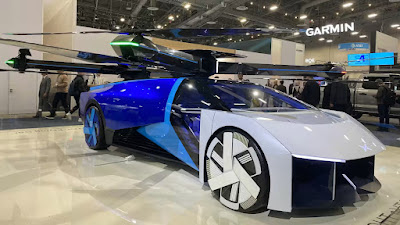Forgotten ONES - In the early months of 1987, Lamborghini embarked on a mission to craft a worthy successor to the iconic Lamborghini Jalpa, initiating the ambitious Lamborghini P140 project. Embracing collaboration, the renowned car manufacturer sought external design expertise alongside their in-house efforts, a customary practice in the dynamic automotive landscape.
 |
| In 1989, the Chrysler Design Center presented a design proposal for the Lamborghini P140 project. (Picture from: CarsThatNeverMadeItEtc) |
Shortly after the commencement of the P140 endeavor, a pivotal shift occurred as Chrysler acquired Automobili Lamborghini from the Mimram Group in April 1987. This transaction, completed at a reported $25 million, marked a significant return on the Mimram's original $3 million investment. Amidst this change, the focus on the Jalpa's replacement intensified, aiming to rival the offerings from Maranello, Stuttgart, and the emerging Japanese sports car scene, notably the impending Honda NSX.
 |
| The Chrysler's P140 design proposal unveils an exterior reminiscent of the Lamborghini Portofino Concept, evoking echoes of the 1991 Dodge M4S Turbo Interceptor 'Wraith.' (Picture from: CarsThatNeverMadeItEtc) |
Parallel to the P140 project, Lamborghini was concurrently engrossed in developing a successor for the legendary Countach. This dual commitment stretched the company's research and development resources to their limits.
Technically, the P140 featured a bonded aluminum monocoque chassis, boasting a 2,522 mm wheelbase, an extension by 71 mm compared to its predecessor, the Jalpa. Suspension incorporated double wishbones, coil-sprung damper units on all corners, and anti-roll bars at both ends. Ventilated four-wheel discs handled braking duties, while the track dimensions were notably wider than the Jalpa.
 |
| Regrettably, the Chrysler model had to take a backseat as Lamborghini opted for Gandini's P140 design, given his rich history with the marque, having previously sculpted several Raging Bull masterpieces like the Miura, Espada, and Countach. (Picture from: CarsThatNeverMadeItEtc) |
The quest for an exquisite body design led to evaluations of proposals from distinguished designers such as Marcello Gandini of Bertone, and the Chrysler Design Center. Ultimately, Lamborghini chose Gandini's P140 design, considering his extensive history with the marque, having previously crafted masterpieces like the Miura, Espada, and Countach.
 |
| The Marcello Gandini's designed Lamborghini P140 while sat on display at the Museo Lamborghini in Sant'Agata Bolognese, Italy. (Picture from: OtoBlitz) |
Meanwhile, the Chrysler Design Center's proposal, though intriguing, succumbed to the passage of time. A glimpse into Chrysler's P140 design surfaced through Story-Cars on X/Twitter, revealing an exterior akin to the Lamborghini Portofino Concept and evoking memories of the 1991 Dodge M4S Turbo Interceptor 'Wraith.' Sadly, the fate of this Chrysler model, a full-scale prototype without an engine, remains shrouded in mystery.
 |
| The 1990 Lamborghini P140 boasts a carbon fiber body atop a purpose-built aluminum monocoque chassis, tailored for the 2,800 lbs (around 1,270 kg) lightweight supercar. (Picture from: OtoBlitz) |
Despite nearing production readiness with a slated 1992 launch, Chrysler abruptly terminated the P140 program in its final developmental stages. The vehicle met an untimely demise, never getting the chance to grace the production line. Subsequently, Chrysler relinquished control of Lamborghini to the Malaysian investment group Mycom Setdco and the Indonesian group V Power Corporation.
 |
| The 1995 Lamborghini Calà Concept by ItalDesign, crafted upon one of the three P140 chassis, currently stands in the Lamborghini Museum alongside its predecessor, embodying a 15-year quest to follow in the footsteps of the cherished Jalpa. (Picture from: Wikipedia) |
Today, one of the three prototypes of Gandini's P140 finds its home in Lamborghini's museum, while another underwent a transformation into the striking Lamborghini Calà concept of 1995. This project, another endeavor to introduce a production-viable, V10-engined Lamborghini, met a similar fate. The Calà now resides alongside its predecessor in the Lamborghini Museum, symbolizing a 15-year journey to succeed the beloved Jalpa. In the realm of automotive history, the Lamborghini P140 remains a captivating tale of innovation, collaboration, and the twists and turns of the industry's evolution.
 In the halls of Lamborghini's museum, these prototypes stand as testament to a bygone era, encapsulating the spirit of daring designs and unrealized dreams. The P140's legacy, though short-lived, echoes through Lamborghini's narrative, reminding enthusiasts of the brand's relentless pursuit of automotive excellence. The journey from the drawing board to the museum showcases the intricate dance between creativity and practicality, a dance that defines the ever-evolving landscape of luxury sports car manufacturing. *** [EKA | FROM VARIOUS SOURCES | STORY-CARS ON TWITTER | EVO.CO.UK | SUPERCARNOSTALGIA | BA-BAMAIL | CONCEPTCARS | CARSTHATNEVERMADEITETC ]
In the halls of Lamborghini's museum, these prototypes stand as testament to a bygone era, encapsulating the spirit of daring designs and unrealized dreams. The P140's legacy, though short-lived, echoes through Lamborghini's narrative, reminding enthusiasts of the brand's relentless pursuit of automotive excellence. The journey from the drawing board to the museum showcases the intricate dance between creativity and practicality, a dance that defines the ever-evolving landscape of luxury sports car manufacturing. *** [EKA | FROM VARIOUS SOURCES | STORY-CARS ON TWITTER | EVO.CO.UK | SUPERCARNOSTALGIA | BA-BAMAIL | CONCEPTCARS | CARSTHATNEVERMADEITETC ] Note: This blog can be accessed via your smart phone.



































